Combating Desertification through the Wine Industry in Hongsibu, Ningxia
Abstract
1. Introduction
2. Materials and Methods
2.1. Study Region
2.2. Hongsibu’s Wine Industry for Combating Desertification
2.3. Evaluation of the Comprehensive Benefits
2.3.1. Construction of an Indicator System of the Comprehensive Benefits
2.3.2. Indicator Selection and Refinement
2.3.3. Determination of the Relative Weight of Indicators
2.3.4. Data Standardization Processing
3. Results
3.1. Changes in the Ecological Environment after the Wine Industry Development
3.2. Ecosystem Services of the Wine Industry
3.3. Economic Benefits of the Wine Industry
3.4. Comprehensive Benefits of Wine Industry Development
4. Discussion
4.1. Ecological Value of the Wine Industry for Desertification Prevention
4.2. Economic and Social Benefits for Combating Desertification
4.3. Comprehensive Benefits of the Wine Industry for Desertification Control
5. Conclusions
Supplementary Materials
Author Contributions
Funding
Data Availability Statement
Acknowledgments
Conflicts of Interest
References
- An, H.; Li, Q.L.; Yan, X.; Wu, X.Z.; Liu, R.T.; Fang, Y. Desertification control on soil inorganic and organic carbon accumulation in the topsoil of desert grassland in Ningxia, northwest China. Ecol. Eng. 2019, 127, 348–355. [Google Scholar] [CrossRef]
- Chen, X.H.; Duan, Z.H. Changes in soil physical and chemical properties during reversal of desertification in Yanchi County of Ningxia Hui autonomous region, China. Environ. Geol. 2009, 57, 975–985. [Google Scholar] [CrossRef]
- Mitchell, D.J.; Fullen, M.A.; Trueman, I.C.; Fearnehough, W. Sustainability of reclaimed desertified land in Ningxia, China. J. Arid Environ. 1998, 39, 239–251. [Google Scholar] [CrossRef]
- Balmford, A.; Bruner, A.; Cooper, P.; Costanza, R.; Farber, S.; Green, R.E.; Jenkins, M.; Jefferiss, P.; Jessamy, V.; Madden, J.; et al. Economic Reasons for Conserving Wild Nature. Science 2002, 297, 950–953. [Google Scholar] [CrossRef]
- He, M.Z.; Zheng, J.G.; Li, X.R.; Qian, Y.L. Environmental factors affecting vegetation composition in the Alxa Plateau, China. J. Arid Environ. 2007, 69, 473–489. [Google Scholar] [CrossRef]
- Jiang, C.; Liu, J.G.; Zhang, H.Y.; Zhang, Z.D.; Wang, D.W. China’s progress towards sustainable land degradation control: Insights from the northwest arid regions. Ecol. Eng. 2019, 127, 75–87. [Google Scholar] [CrossRef]
- Miao, L.J.; Moore, J.C.; Zeng, F.J.; Lei, J.Q.; Ding, J.L.; He, B.; Cui, X.F. Footprint of Research in Desertification Management in China. Land Degrad. Dev. 2015, 26, 450–457. [Google Scholar] [CrossRef]
- Wang, X.H.; Lu, C.H.; Fang, J.F.; Shen, Y.C. Implications for development of grain-for-green policy based on cropland suitability evaluation in desertification-affected north China. Land Use Policy 2007, 24, 417–424. [Google Scholar] [CrossRef]
- Zhao, H.L.; Cui, J.Y.; Zhou, R.L.; Zhang, T.H.; Zhao, X.Y.; Drake, S. Soil properties, crop productivity and irrigation effects on five croplands of Inner Mongolia. Soil Till. Res. 2007, 93, 346–355. [Google Scholar] [CrossRef]
- Zhang, Z.H.; Huisingh, D. Combating desertification in China: Monitoring, control, management and revegetation. J. Clean. Prod. 2018, 182, 765–775. [Google Scholar] [CrossRef]
- Feng, Q.; Tian, Y.Z.; Yu, T.F.; Yin, Z.L.; Cao, S.X. Combating desertification through economic development in northwestern China. Land Degrad. Dev. 2019, 30, 910–917. [Google Scholar] [CrossRef]
- Cao, S.X.; Zhong, B.L.; Yue, H.; Zeng, H.S.; Zeng, J.H. Development and testing of a sustainable environmental restoration policy on eradicating the poverty trap in China’s Changting County. Proc. Natl. Acad. Sci. USA 2009, 106, 10712–10716. [Google Scholar] [CrossRef] [PubMed]
- Chen, Y.; Tang, H. Desertification in north China: Background, anthropogenic impacts and failures in combating it. Land Degrad. Dev. 2005, 16, 367–376. [Google Scholar] [CrossRef]
- Sun, D.F.; Yu, X.Q.; Liu, X.N.; Li, B.G. A new artificial oasis landscape dynamics in semi-arid Hongsipu region with decadal agricultural irrigation development in Ning Xia, China. Earth Sci. Inform. 2016, 9, 21–33. [Google Scholar] [CrossRef]
- Yang, B.H.; Yao, H.; Zhang, J.X.; Li, Y.Q.; Ju, Y.L.; Zhao, X.F.; Sun, X.Y.; Fang, Y.L. Effect of regulated deficit irrigation on the content of soluble sugars, organic acids and endogenous hormones in Cabernet Sauvignon in the Ningxia region of China. Food Chem. 2020, 312, 126020. [Google Scholar] [CrossRef]
- Gougeon, L.; Da Costa, G.; Le Mao, I.; Ma, W.; Teissedre, P.-L.; Guyon, F.; Richard, T. Wine analysis and authenticity using 1H-NMR metabolomics data: Application to Chinese wines. Food Anal. Methods 2018, 11, 3425–3434. [Google Scholar] [CrossRef]
- Li, Z.; Pan, Q.H.; Jin, Z.M.; Mu, L.; Duan, C.Q. Comparison on phenolic compounds in Vitis vinifera cv. Cabernet Sauvignon wines from five wine-growing regions in China. Food Chem. 2011, 125, 77–83. [Google Scholar] [CrossRef]
- Sun, Y.L.; Liu, Q.Z.; Xi, B.; Dai, H.J. Study on the regulation of anthocyanin biosynthesis by exogenous abscisic acid in grapevine. Sci. Hortic. 2019, 250, 294–301. [Google Scholar] [CrossRef]
- Li, L.X.; Sun, B.S. Grape and wine polymeric polyphenols: Their importance in enology. Crit. Rev. Food Sci. Nutr. 2019, 59, 563–579. [Google Scholar] [CrossRef] [PubMed]
- Marsal, J.; Mata, M.; del Campo, J.; Arbones, A.; Vallverdú, X.; Girona, J.; Olivo, N. Evaluation of partial root-zone drying for potential field use as a deficit irrigation technique in commercial vineyards according to two different pipeline layouts. Irrig. Sci. 2008, 26, 347–356. [Google Scholar] [CrossRef]
- Zhang, Q.T.; Wang, S.P.; Li, L.; Inoue, M.; Xiang, J.; Qiu, G.Y.; Jin, W.B. Effects of mulching and sub-surface irrigation on vine growth, berry sugar content and water use of grapevines. Agric. Water Manag. 2014, 143, 1–8. [Google Scholar] [CrossRef]
- Wang, S.; Li, H.; Wang, H. Wind erosion prevention effect of suspending shoots on wires after winter pruning in soil-burying zones over-wintering. Trans. Chin. Soc. Agric. Eng. 2015, 31, 206–212. [Google Scholar]
- Rusch, A.; Delbac, L.; Thiéry, D. Grape moth density in Bordeaux vineyards depends on local habitat management despite effects of landscape heterogeneity on their biological control. J. Appl. Ecol. 2017, 54, 1794–1803. [Google Scholar] [CrossRef]
- Wang, X.Q.; Xie, X.L.; Chen, N.; Wang, H.; Li, H. Study on current status and climatic characteristics of wine regions in China. Vitis 2018, 57, 9–16. [Google Scholar]
- Li, H.; Wang, H. Extremely simplified grapevine cultivation. Sino-Overseas Grapevine Wine 2020, 4, 47–51. [Google Scholar]
- Ma, C.; Wang, X.B.; Zhang, W.H. A relict habitat became an isolated habitat in the Luoshan Nature Reserve from 1977 to 2017: Natural or man-made disaster? Nat. Resour. Forum 2019, 43, 164–180. [Google Scholar] [CrossRef]
- Garcia, L.; Celette, F.; Gary, C.; Ripoche, A.; Valdés-Gómez, H.; Metay, A. Management of service crops for the provision of ecosystem services in vineyards: A review. Agric. Ecosyst. Environ. 2018, 251, 158–170. [Google Scholar] [CrossRef]
- Guo, W.H.; Kang, S.Z.; Li, F.S. Variation of NEE and its controlling factors in a vineyard of arid region of northwest China. Atmos. Environ. 2014, 84, 349–354. [Google Scholar] [CrossRef]
- Li, T.; Cui, Y.H.; Liu, A.G. Spatiotemporal dynamic analysis of forest ecosystem services using “big data”: A case study of Anhui province, central-eastern China. J. Clean. Prod. 2017, 142, 589–599. [Google Scholar] [CrossRef]
- Song, Z.W.; Sun, M.Y.; Yang, R.J.; Dou, G.Y.; Zhang, Y.; Zhang, L. Evaluation of ecosystem service value of the grape industry at the eastern foot of Helan Mountain, Ningxia, China. J. Appl. Ecol. 2019, 30, 979–985. [Google Scholar]
- Wei, H.L.; Qi, Y.J. Estimation and analysis of forest ecosystem services value: Case study in Baishuijiang National Nature Reserve in Gansu, western China. J. Bejing For. Univ. 2016, 38, 74–82. [Google Scholar]
- Rosas-Ramos, N.; Baños-Picón, L.; Tobajas, E.; De Paz, V.; Tormos, J.; Asís, J.D. Value of ecological infrastructure diversity in the maintenance of spider assemblages: A case study of Mediterranean vineyard agroecosystems. Agric. Ecosyst. Environ. 2018, 265, 244–253. [Google Scholar] [CrossRef]
- Wang, L.; Liu, J.M.; Wang, L.E.; Zhu, H.; Lin, J. Tourism resource assessment and spatial analysis of wine tourism development: A case study of the eastern foothills of China’s Helan Mountains. J. Mt. Sci. 2018, 15, 645–656. [Google Scholar] [CrossRef]
- Ferrari, V.; Taffarel, S.R.; Espinosa-Fuentes, E.; Oliveira, M.L.; Saikia, B.K.; Oliveira, L.F. Chemical evaluation of by-products of the grape industry as potential agricultural fertilizers. J. Clean. Prod. 2019, 208, 297–306. [Google Scholar] [CrossRef]
- Rigby, D.; Woodhouse, P.; Young, T.; Burton, M. Constructing a farm level indicator of sustainable agricultural practice. Ecol. Econ. 2001, 39, 463–478. [Google Scholar] [CrossRef]
- Zhao, F.J.; Wang, Y.J.; Jiang, Z.D. County-level walnut industry development evaluation system and its application. Issues For. Econ. 2010, 30, 447–451. [Google Scholar]
- Zhu, H.J.; Yao, S.B. Study on the coupling process of ecological economic system of desertification control in the Ningxia Hui Autonomous Region. Sci. Tech. Manag. Res. 2015, 35, 242–245. [Google Scholar]
- Sun, L.F. Structure and evaluation on indicators system of sustainable development of Xinjiang featured forestry and fruit industry. Xinjiang Agric. Sci. 2009, 46, 678–685. [Google Scholar]
- Zhu, H.J. Study on Synthetic Benefit Evaluation on Desertification Control in Ningxia Hui Autonomous Region; Northwest Agriculture & Forestry University: Shaanxi, China, 2015; Chapter VII; pp. 80–89. [Google Scholar]
- Geng, Z.Q.; Zhao, S.S.; Tao, G.C.; Han, Y.M. Early warning modeling and analysis based on analytic hierarchy process integrated extreme learning machine (AHP-ELM): Application to food safety. Food Control. 2017, 78, 33–42. [Google Scholar] [CrossRef]
- Assandri, G.; Bogliani, G.; Pedrini, P.; Brambilla, M. Beautiful agricultural landscapes promote cultural ecosystem services and biodiversity conservation. Agric. Ecosyst. Environ. 2018, 256, 200–210. [Google Scholar] [CrossRef]
- Wang, R.; Sun, Q.; Chang, Q.R. Soil Types Effect on Grape and Wine Composition in Helan Mountain Area of Ningxia. PLoS ONE 2015, 10, e0116690. [Google Scholar] [CrossRef] [PubMed]
- Sun, D.F.; Richard, D.; Li, B.G. Agricultural causes of desertification risk in Minqin, China. J. Environ. Manag. 2006, 79, 348–356. [Google Scholar]
- Brunori, E.; Farina, R.; Biasi, R. Sustainable viticulture: The carbon-sink function of the vineyard agro-ecosystem. Agric. Ecosyst. Environ. 2016, 223, 10–21. [Google Scholar] [CrossRef]
- Daane, K.M.; Hogg, B.N.; Wilson, H.; Yokota, G.Y. Native grass ground covers provide multiple ecosystem services in Californian vineyards. J. Appl. Ecol. 2018, 55, 2473–2483. [Google Scholar] [CrossRef]
- Li, H.Y.; Zhang, X.Y.; Wang, J.; Zhang, L.; Yang, Y. Ecological suitability regionalization of wine grape with different ripening dates in Ningxia. Chin. J. Ecol. 2014, 33, 3120–3126. [Google Scholar]
- Liu, N.; Qin, Y.; Song, Y.Y.; Tao, Y.S.; Sun, Y.; Liu, Y.L. Aroma composition and sensory quality of Cabernet Sauvignon wines fermented by indigenous saccharomyces cerevisiae strains in the Eastern Base of the Helan Mountain, China. Int. J. Food Prop. 2016, 19, 2417–2431. [Google Scholar] [CrossRef]
- Li, S.Y.; Tang, Q.L.; Lei, J.Q.; Xu, X.W.; Jiang, J.; Wang, Y.D. An overview of non-conventional water resource utilization technologies for biological sand control in Xinjiang, northwest China. Environ. Earth Sci. 2015, 73, 873–885. [Google Scholar] [CrossRef]
- Ayars, J.E.; Abrisqueta, I.; Parry, C.; Perry, A.; McElrone, A.J. Water Management of Irrigated Cabernet Sauvignon Grapevines in Semi-Arid Areas. Am. J. Enol. Vitic. 2017, 68, 458–467. [Google Scholar] [CrossRef]
- Savi, T.; Petruzzellis, F.; Martellos, S.; Stenni, B.; Borgo, A.D.; Zini, L.; Lisjak, K.; Nardini, A. Vineyard water relations in a karstic area: Deep roots and irrigation management. Agric. Ecosyst. Environ. 2018, 263, 53–59. [Google Scholar] [CrossRef]
- Wang, R.; Yan, P.K.; Sun, Q.; Su, B.F.; Zhang, J.X. Effects of regulated deficit irrigation on the growth and berry composition of Cabernet Sauvignon in Ningxia. Int. J. Agric. Biol. Eng. 2019, 12, 102–109. [Google Scholar] [CrossRef]
- Teslić, N.; Vujadinović, M.; Ruml, M.; Ricci, A.; Vuković, A.; Parpinello, G.P.; Versari, A. Future climatic suitability of the Emilia-Romagna (Italy) region for grape production. Reg. Environ. Chang. 2018, 19, 599–614. [Google Scholar] [CrossRef]
- Niles, M.T.; Garrett, R.D.; Walsh, D. Ecological and economic benefits of integrating sheep into viticulture production. Agron. Sustain. Dev. 2017, 38, 1. [Google Scholar] [CrossRef]
- Schultz, H.R. Global Climate Change, Sustainability, and Some Challenges for Grape and Wine Production. J. Wine Econ. 2016, 11, 181–200. [Google Scholar] [CrossRef]
- Duan, B.; Arcodia, C.; Ma, E.; Hsiao, A. Understanding wine tourism in China using an integrated product-level and experience economy framework. Asia Pac. J. Tour. Res. 2018, 23, 949–960. [Google Scholar] [CrossRef]
- Figueiredo, V.; Franco, M. Wine cooperatives as a form of social entrepreneurship: Empirical evidence about their impact on society. Land Use Policy 2018, 79, 812–821. [Google Scholar] [CrossRef]
- Xue, T.T.; Han, X.; Zhang, H.J.; Wang, Y.; Wang, H.; Li, H. Effects of a biodegradable liquid film on winter chill protection of winegrape cultivars. Sci. Hortic. 2019, 246, 398–406. [Google Scholar] [CrossRef]
- Yang, S.M.; She, H.Y.; Yang, S.C.; Zhu, X.J.; Chen, Y.; Li, J.H.; Li, M.Q. Design and experimental validation of improved grapevine burying machine. Int. J. Agric. Biol. Eng. 2018, 11, 95–100. [Google Scholar] [CrossRef]
- Li, J.Y.; Yang, X.C.; Jin, Y.X.; Yang, Z.; Huang, W.G.; Zhao, L.N.; Gao, T.; Yu, H.D.; Ma, H.L.; Qin, Z.H.; et al. Monitoring and analysis of grassland desertification dynamics using Landsat images in Ningxia, China. Remote Sens. Environ. 2013, 138, 19–26. [Google Scholar] [CrossRef]
- Li, H.; Wang, H. The new model of Chinese wine industry development. Liquor Mak. Sci. Technol. 2010, 198, 99–101. [Google Scholar]
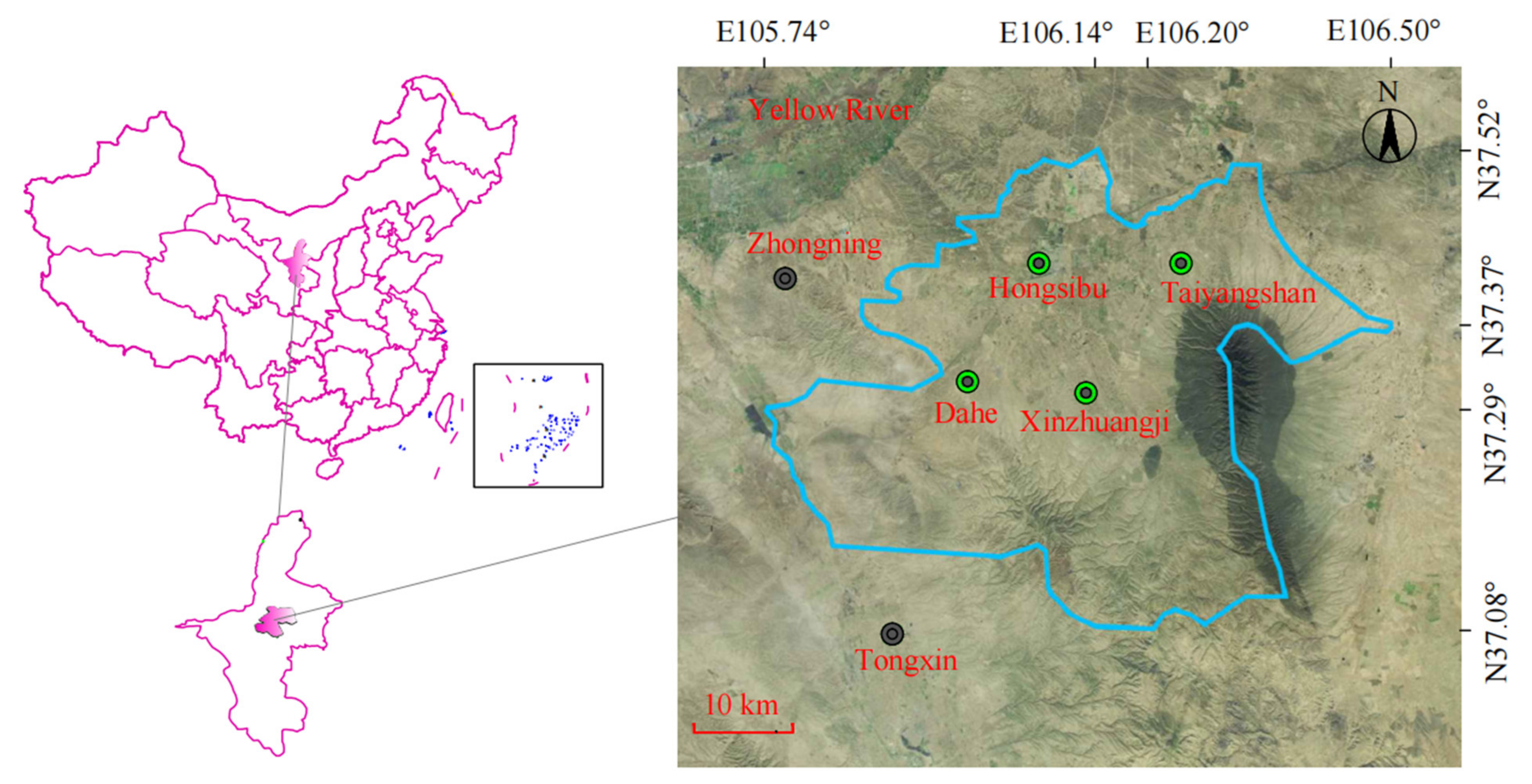
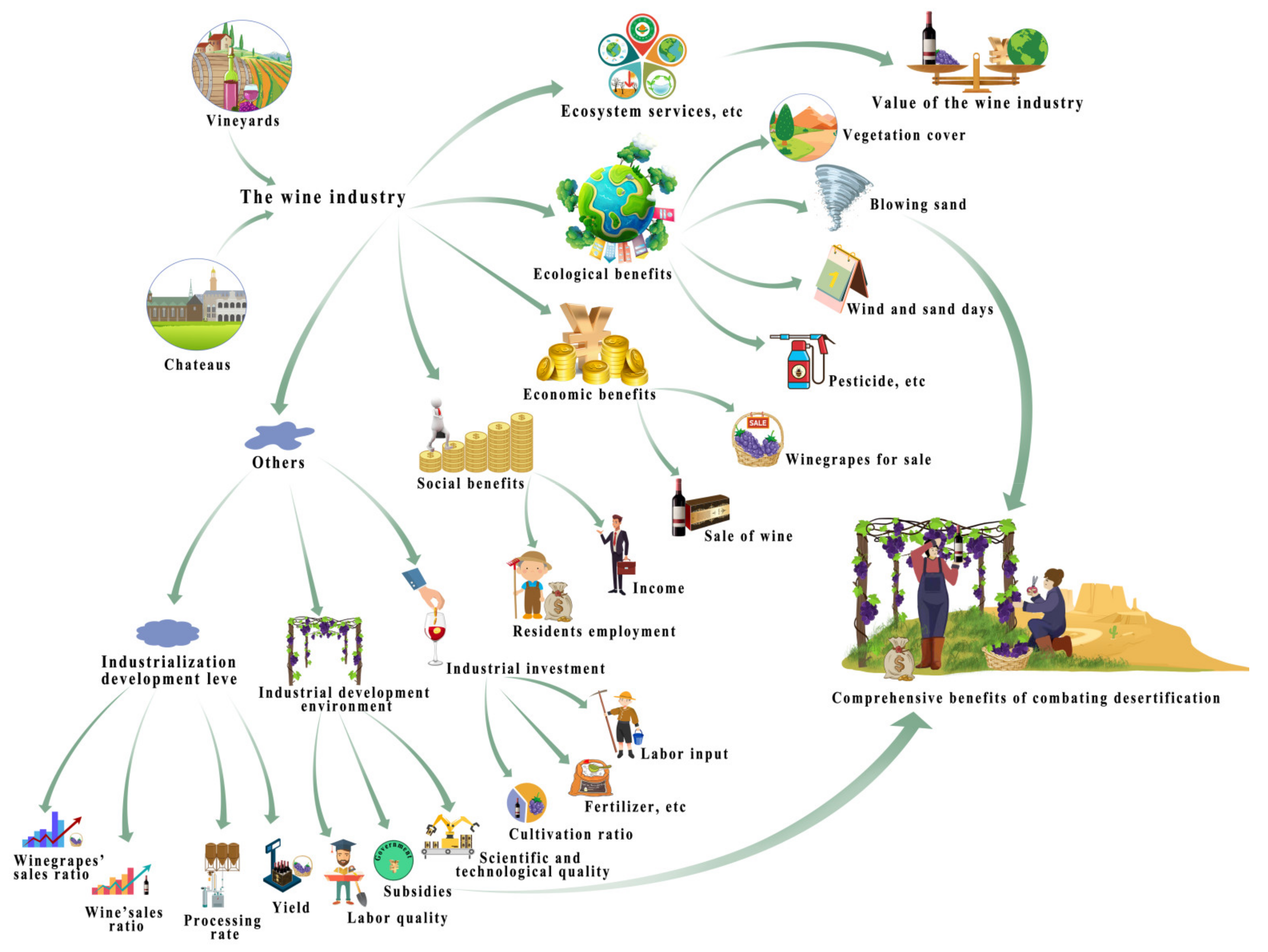
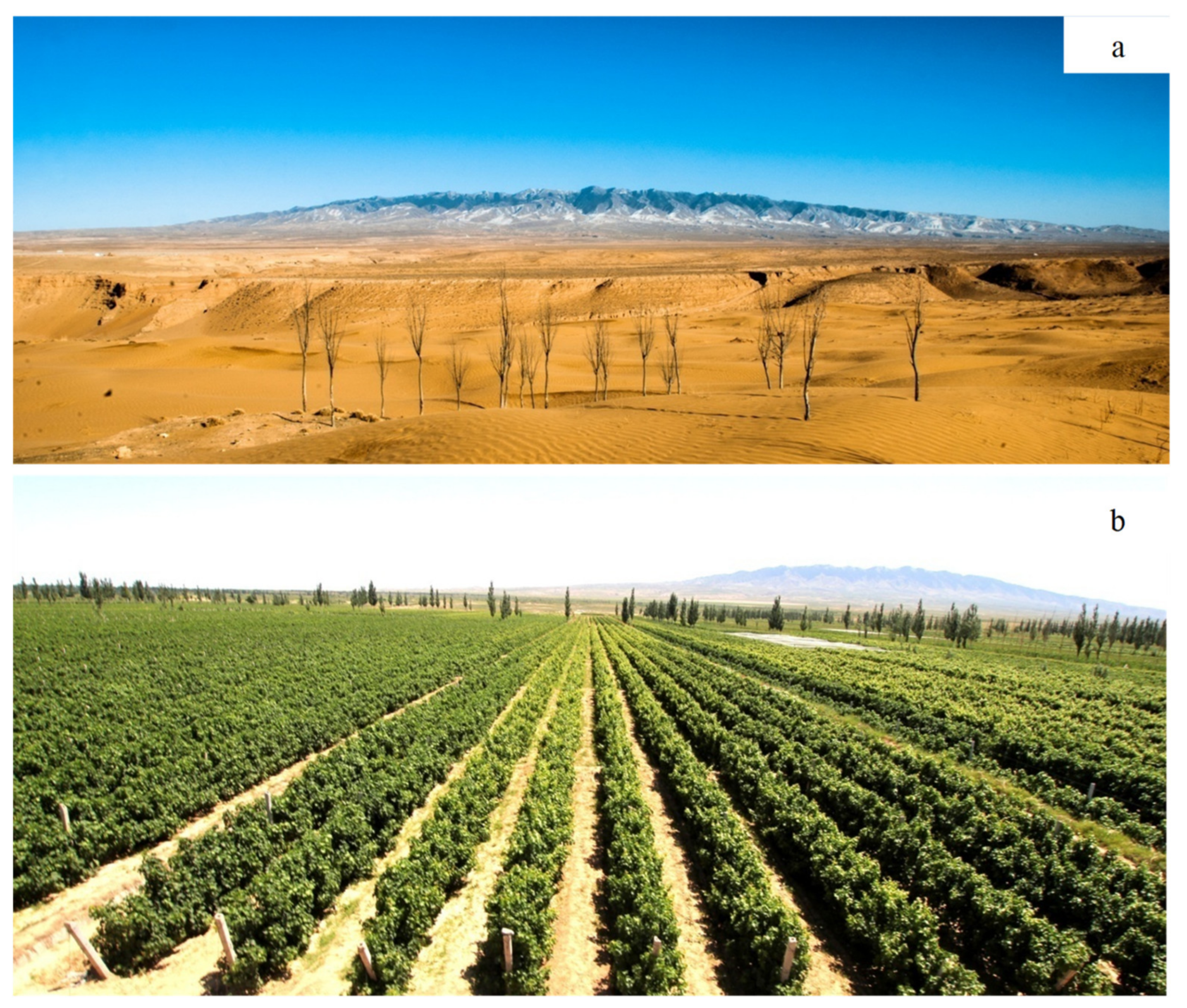
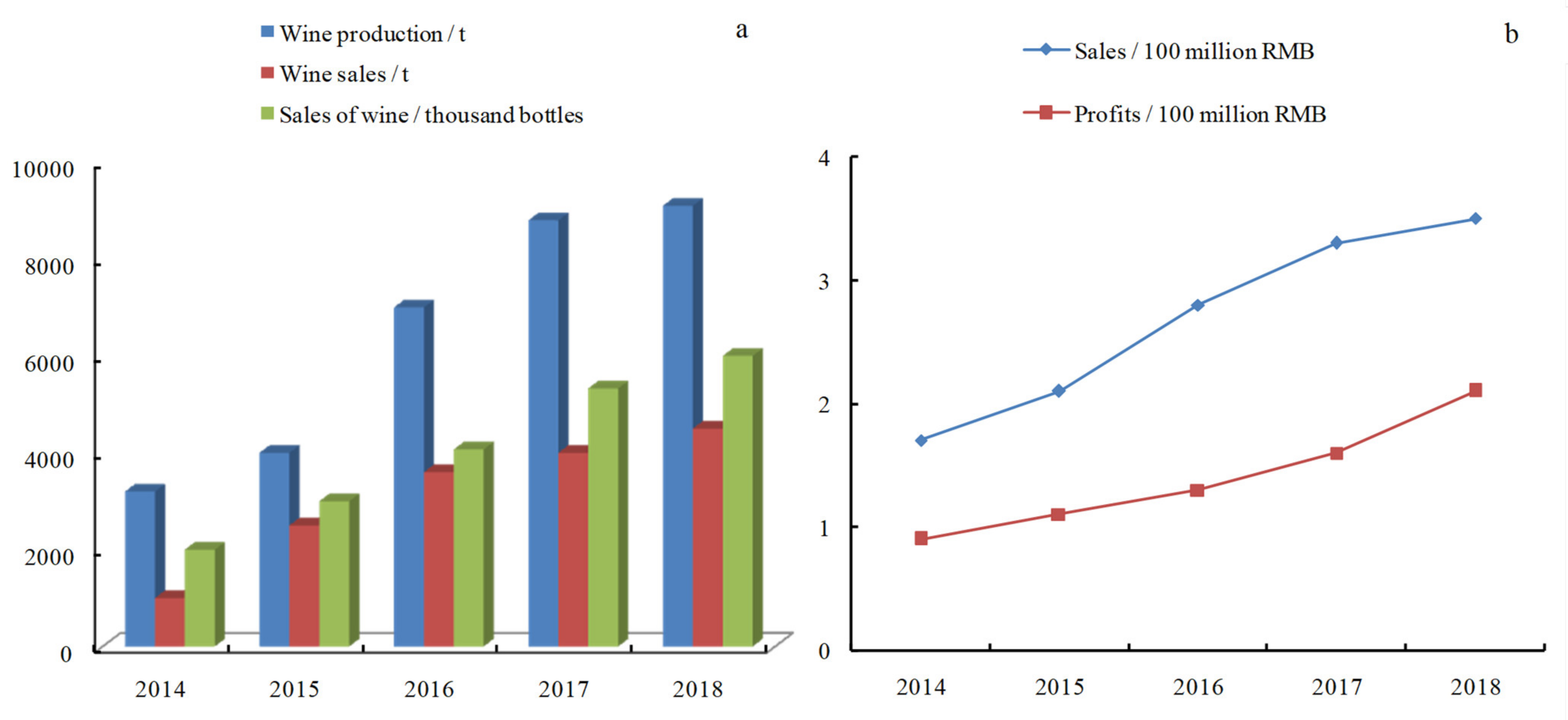
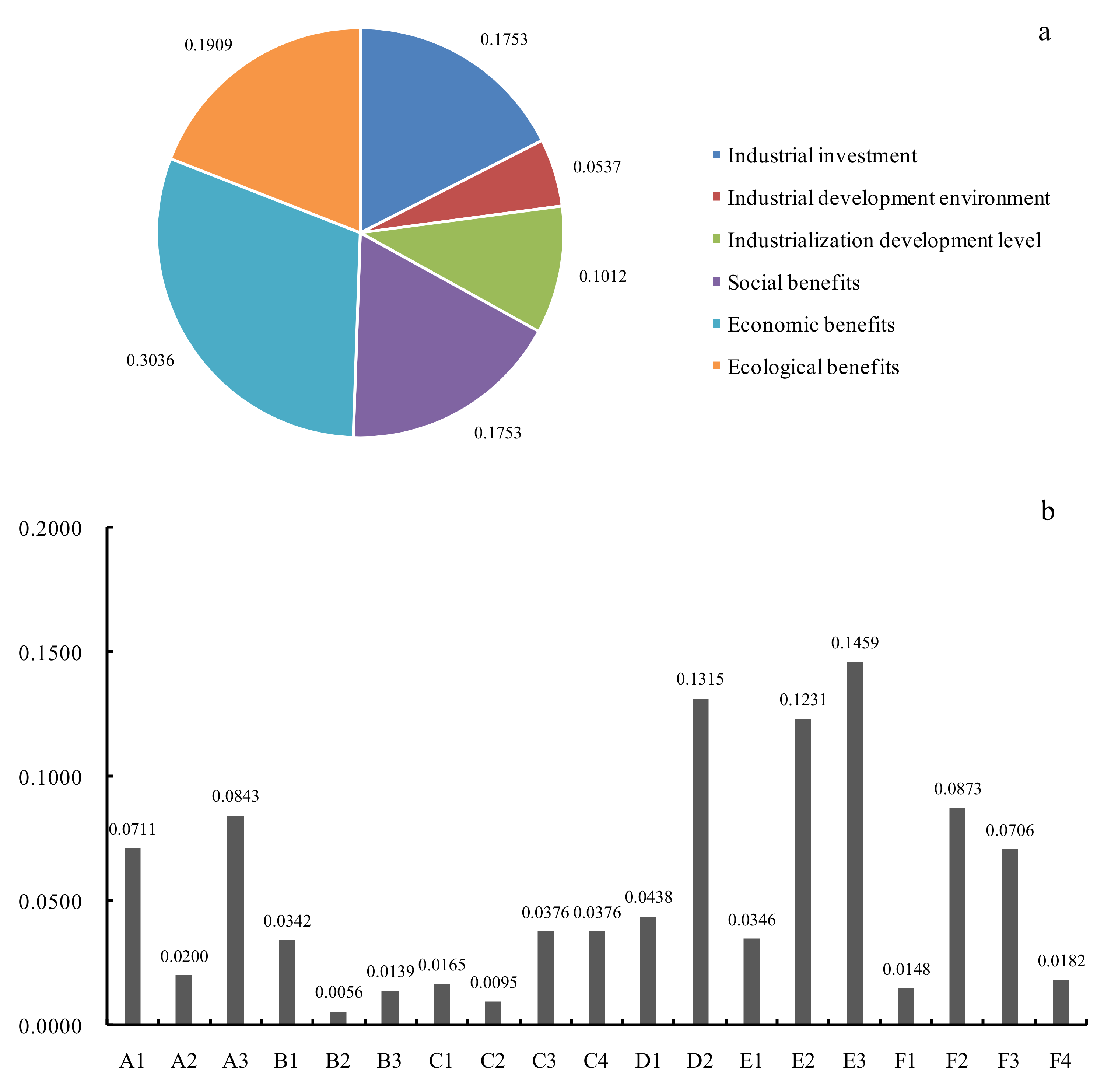
| First-Level Indicators | Second-Level Indicators | Investigation Object | Formula | Unit of Measurement |
|---|---|---|---|---|
| A Industrial investment | A1 Labor input of unit area | Grape growers | A1 = labor input/wine grapes area | number of people/ha |
| A2 Amount of fertilizer per unit area | Grape growers | A2 = fertilizing amount/wine grapes area | RMB/ha | |
| A3 Planting ratio | Grape growers | A3 = wine grapes area/total cultivated area | % | |
| B Industrial development environment | B1 Scientific and technological quality | Grape growers | B1 = scientific and technological input/cost of investment | % |
| B2 Subsidies | Grape growers | B2 = government subsidies/cost of investment | % | |
| B3 Labor quality | Grape growers | B3 = number of labor of middle school or above/total labor | % | |
| C Industrialization development level | C1 Yield per unit area | Grape growers | C1 = wine grapes yield/wine grapes area | t/ha |
| C2 Wine grapes’ sales rate | Grape growers | C2 = amount of wine grapes sales/wine grapes yield | % | |
| C3 Enterprise processing rate | Chateaus | C3 = amount of wine grapes processing/wine grapes yield of chateau | % | |
| C4 Enterprise sales ratio | Chateaus | C4 = wine sales/total amount of wine | % | |
| D Social benefits | D1Employment proportion | Grape growers | D1 = number of wine grapes practitioners/agricultural population | % |
| D2 Poverty alleviation ratio | Grape growers | D2 = number of poor people/number of wine grapes practitioners | % | |
| E Economic benefits | E1 Winegrapes contributes to income | Grape growers | E1 = wine grapes’ income/farmer income | % |
| E2 Winegrapes’ expected contribution to income | Grape growers | E2 = wine grapes’ income at expected maximum fruiting/farmer income | % | |
| E3 Wine contributes to chateau’ income | Chateaus | E3 = wine income/investment cost | % | |
| F Ecological benefits | F1 The proportion of farm manure used | Grape growers | F1 = farm manure usage/total amount of fertilizer | % |
| F2 Reduction rate of desertified land | Chateaus | F2 = wine growing area/land area of chateau | % | |
| F3 Reduction rate of windy and sandy days | Chateaus | F3 = reduced windy and sandy days/total windy and sandy days before the wine industry | % | |
| F4 Amount of pesticide used per unit area | Grape growers | F4 = amount of pesticide used/wine grapes area | RMB/ha |
| Ecological Function | Formulas | Value of the Eastern Foot of Helan Mountain (RMB/Year) | Proportion of Each Function (%) | Value of Hongsibu (RMB/Year) | Proportion of Each Function (%) |
|---|---|---|---|---|---|
| Food production | Wf = P·A | 1.86 × 109 | 56.42 | 3.46 × 108 | 54.96 |
| Carbon sequestration and oxygen release | CV = Pc·N·A·a | 2.51 × 107 | 3.52 | 4.67 × 106 | 3.43 |
| OV = Po·N·A·b | 9.10 × 107 | 1.69 × 107 | |||
| Atmospheric purification | USO2 = KSO2·QSO2·A | 2.05 × 106 | 1.83 | 3.82 × 105 | 4.45 |
| UNOx = KNOx·QNOx·A | 2.74 × 104 | 5.09 × 103 | |||
| UHF = KHF·QHF·A | 1.82 × 104 | 3.39 × 103 | |||
| US = KS·QS·A | 5.81 × 107 | 1.08 × 107 | |||
| Soil conservation | Ws = (A−L)·C·P | 5.65 × 106 | 0.17 | 1.05 × 106 | 0.17 |
| Water resources conservation | Ww = (R−E)·A·P | 4.07 × 106 | 0.12 | 7.58 × 105 | 0.12 |
| Water-saving and efficiency-enhancing | Q = (X−x)·A·P | 8.40 × 106 | 0.25 | 1.56 × 106 | 0.25 |
| Ecotourism | V = P·N·Y | 3.42 × 108 | 10.37 | 6.36 × 107 | 10.10 |
| Ecological poverty alleviation | PA = P·N | 9.00 × 108 | 27.30 | 1.67 × 108 | 26.53 |
| Year | Cultivated Area (ha) | Fruit Area (ha) | Per Unit Yield (kg/ha) | Total Yield (t) | Income Per Unit Area (RMB/ha) | Agricultural Per Capita Net Income (RMB) | Proportion of Wine Grapes in per Capita Net Income (%) |
|---|---|---|---|---|---|---|---|
| 2014 | 5800 | 2578 | 3091.93 | 7971.00 | 10,821.76 | 1008.60 | 49.58 |
| 2015 | 5934 | 2680 | 3638.36 | 9750.80 | 11,642.75 | 1093.20 | 58.54 |
| 2016 | 6500 | 3300 | 3866.06 | 12,758.00 | 12,758.00 | 1185.50 | 60.46 |
| 2017 | 7067 | 3265 | 3982.45 | 13,002.70 | 13,938.58 | 1286.70 | 65.78 |
| 2018 | 7067 | 4150 | 4235.54 | 17,577.49 | 14,824.39 | 1399.80 | 68.50 |
| Secondary Indicators | Actual Value (Av) | Standard Value (Sv) | Standardized Score | ||||
|---|---|---|---|---|---|---|---|
| Sample Size | Average Value | Standard Deviation | Number of Interviews | Average Value | Standard Deviation | ||
| A1 | 108 | 1.96 | 1.43 | 5 | 2.46 | 0.38 | 79.58% |
| A2 | 108 | 4565.64 | 194.51 | 5 | 4940.00 | 135.65 | 92.42% |
| A3 | 108 | 0.91 | 0.20 | 5 | 1.12 | 0.12 | 81.30% |
| B1 | 108 | 0.47 | 0.10 | 5 | 0.82 | 0.09 | 57.42% |
| B2 | 108 | 0.03 | 0.01 | 5 | 0.04 | 0.01 | 64.52% |
| B3 | 108 | 0.70 | 0.28 | 5 | 1.27 | 0.45 | 55.36% |
| C1 | 108 | 10.22 | 3.60 | 5 | 11.32 | 0.75 | 90.24% |
| C2 | 108 | 0.92 | 0.22 | 5 | 1.18 | 0.42 | 78.08% |
| C3 | 10 | 1.00 | 0.00 | 5 | 1.16 | 0.10 | 86.21% |
| C4 | 10 | 0.83 | 0.15 | 5 | 0.96 | 0.04 | 86.68% |
| D1 | 108 | 0.78 | 0.25 | 5 | 0.95 | 0.04 | 81.92% |
| D2 | 108 | 0.66 | 0.47 | 5 | 0.84 | 0.05 | 78.64% |
| E1 | 108 | 0.67 | 0.21 | 5 | 0.87 | 0.04 | 76.60% |
| E2 | 108 | 0.86 | 0.34 | 5 | 0.92 | 0.04 | 93.39% |
| E3 | 10 | 0.04 | 0.02 | 5 | 0.05 | 0.01 | 83.51% |
| F1 | 108 | 0.46 | 0.10 | 5 | 0.60 | 0.13 | 75.93% |
| F2 | 10 | 0.74 | 0.08 | 5 | 0.93 | 0.06 | 79.66% |
| F3 | 10 | 0.71 | 0.07 | 5 | 0.82 | 0.06 | 86.80% |
| F4 | 108 | 745.33 | 67.00 | 5 | 492.00 | 39.19 | 66.01% |
Publisher’s Note: MDPI stays neutral with regard to jurisdictional claims in published maps and institutional affiliations. |
© 2021 by the authors. Licensee MDPI, Basel, Switzerland. This article is an open access article distributed under the terms and conditions of the Creative Commons Attribution (CC BY) license (https://creativecommons.org/licenses/by/4.0/).
Share and Cite
Zhang, L.; Wang, Z.; Xue, T.; Gao, F.; Wei, R.; Wang, Y.; Han, X.; Li, H.; Wang, H. Combating Desertification through the Wine Industry in Hongsibu, Ningxia. Sustainability 2021, 13, 5654. https://doi.org/10.3390/su13105654
Zhang L, Wang Z, Xue T, Gao F, Wei R, Wang Y, Han X, Li H, Wang H. Combating Desertification through the Wine Industry in Hongsibu, Ningxia. Sustainability. 2021; 13(10):5654. https://doi.org/10.3390/su13105654
Chicago/Turabian StyleZhang, Liang, Zhilei Wang, Tingting Xue, Feifei Gao, Ruteng Wei, Ying Wang, Xing Han, Hua Li, and Hua Wang. 2021. "Combating Desertification through the Wine Industry in Hongsibu, Ningxia" Sustainability 13, no. 10: 5654. https://doi.org/10.3390/su13105654
APA StyleZhang, L., Wang, Z., Xue, T., Gao, F., Wei, R., Wang, Y., Han, X., Li, H., & Wang, H. (2021). Combating Desertification through the Wine Industry in Hongsibu, Ningxia. Sustainability, 13(10), 5654. https://doi.org/10.3390/su13105654







